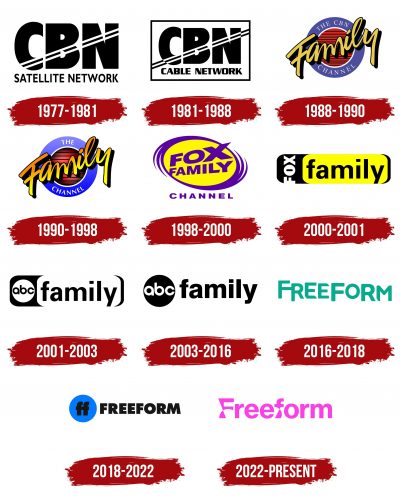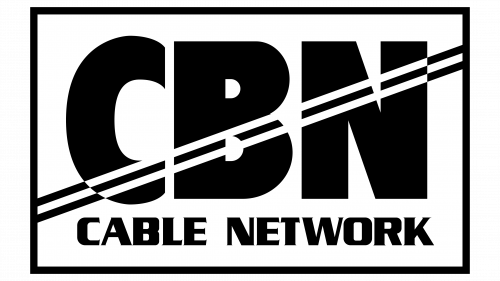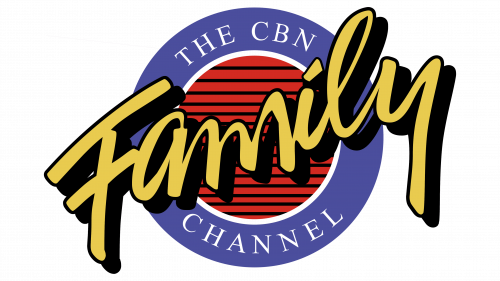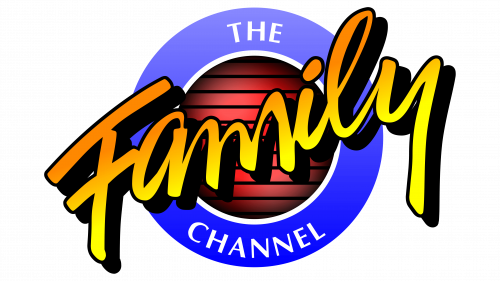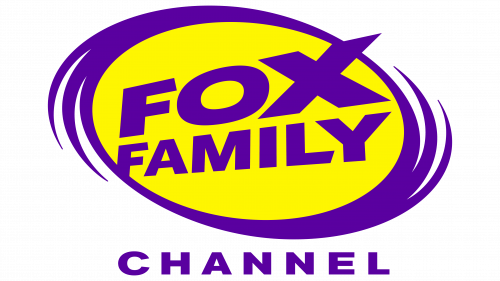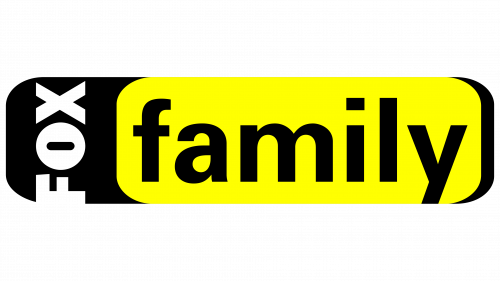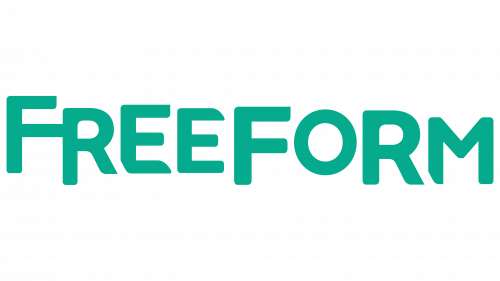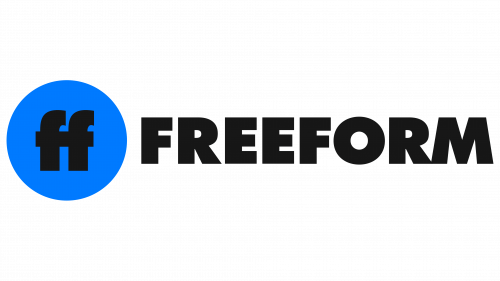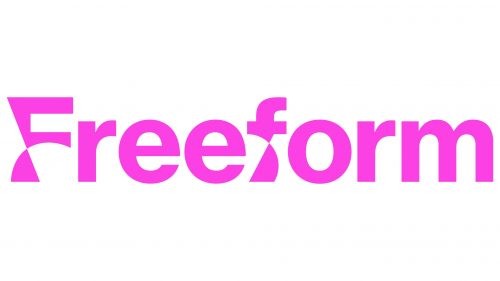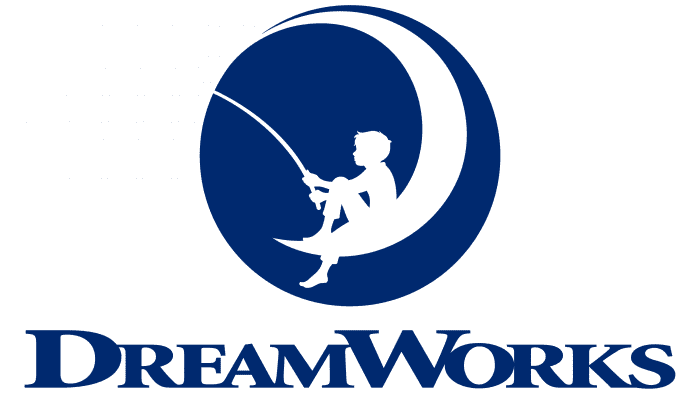The FreeForm logo conveys a sense of freedom and creativity through unusual, asymmetrical shapes that successfully resonate with the channel’s name. Visually, the emblem reflects a lack of rigid boundaries and limitations, emphasizing the brand’s focus on a modern generation of viewers seeking self-expression and new ideas.
The symbol represents the channel’s values, offering a fresh perspective on reality, breaking stereotypes, and creating space for individuality and experimentation. Every line and curve of the logo exudes dynamism and movement, indicating the channel’s constant growth and adaptation to the current youth demands.
FreeForm: Brand overview
The channel’s history dates back long before it adopted its current name. It was originally launched as CBN Satellite Service, a religious cable station founded by televangelist Pat Robertson on April 29, 1977. The station aired family programming and religious content.
In 1981, the channel rebranded as CBN Cable Network to reflect its growing range of shows and incorporate more secular content, including classic TV series and movies. In 1988, it changed names again, becoming The Family Channel, marking a shift toward family-friendly programming and aiming to attract a broader audience.
1990, the station separated from the Christian Broadcasting Network to preserve its non-profit status. A new company, International Family Entertainment, was formed to manage it. In 1997, The Family Channel was sold to News Corporation and Saban Entertainment for $1.9 billion and rebranded as Fox Family, emphasizing teen dramas and children’s programming more.
In 2001, Disney acquired Fox Family Worldwide for $5.3 billion and renamed ABC Family in November. Under the new name, the channel expanded its programming to appeal to a younger audience, airing hit shows like The Secret Life of the American Teenager (2008-2013) and Kyle XY (2006-2009).
One of the network’s most enduring traditions, the 25 Days of Christmas movie marathon, first aired in 2006 and became a signature feature. In 2007, the network introduced the tagline “A New Kind of Family,” reflecting a more modern and inclusive concept of family programming.
2010, the channel entered a highly successful period, launching several hit series, including Pretty Little Liars (2010–2017), which became one of its top-rated shows. By 2014, the network ranked sixth among cable channels for prime-time viewing among women aged 18-34, demonstrating its appeal to younger viewers.
A major shift occurred on January 6, 2016, when the network rebranded, targeting young adults aged 14 to 34, referred to as “becomers,” people in transitional life stages. After the rebranding, the channel continued to grow its original programming slate, premiering series like Shadowhunters (2016–2019), The Bold Type (2017–2021), and Grown-ish (2018–present).
In 2018, the network launched a new programming strategy called “A Little Forward,” focusing on content emphasizing inclusivity and diversity. In 2019, the network introduced several original shows, including Good Trouble and Motherland: Fort Salem, which were well-received by critics and audiences alike.
Despite global challenges in 2020, the channel continued producing original content, adapting to new production realities. In 2021, the network set a record with the premiere of Cruel Summer, which became its most-watched series debut in history.
By 2022, the channel had firmly established itself as a hub for younger audiences, focusing on inclusive and diverse storytelling. As of 2023, it continues producing content that resonates with its target audience while staying attuned to evolving viewer preferences and advancements in the television industry.
Throughout its long history, the channel has evolved from a religious broadcaster into a platform for youth-oriented programming, all while maintaining its commitment to quality entertainment and family values.
Meaning and History
What is FreeForm?
This is a lively television network aimed at youth and teens. The Disney-owned channel initially debuted under a different name but eventually became a leading force in the youth television industry. The channel’s lineup of original shows, popular movies, and acquired content is carefully selected to capture the interest of its core audience. The network is known for taking risks in its storytelling; many programs address relevant topics and present diverse perspectives. Among the available entertainment is a variety of content — from Christmas specials to spooky thrillers and quirky comedies — which keeps viewers engaged and makes the network appealing to a broad audience.
1977 – 1981
The channel was launched as a religious one in 1977. The first logo consists of the abbreviation of the name: three capital letters, black, massive letters, and CBN, which stands for Christian Broadcasting Network. The monumental and impressive letters created a sense of firmness in beliefs and clarity of the channel’s mission, which was based on Christian values.
Two diagonal lines run through the inscription, directed upwards. This element can be interpreted in different ways:
- The lines may be associated with rays of light, as if descending from the heavens, symbolizing faith and divine blessing.
- The lines also resemble antennas or satellites, referring to the modern technologies used to transmit signals at the time.
Under the main title was an additional inscription — “Satellite Service,” pointing to the technical aspect of the channel’s operation and its connection to satellite broadcasting.
1981 – 1988
The channel shifted its focus to family content, which led to an update of the logo. The CBN abbreviation was now placed inside a rectangle, symbolizing a television or computer screen. This rectangle represents a closed and unified structure, emphasizing unity when the family gathers to watch programs.
Diagonal lines run across the entire rectangle, symbolizing television waves or wires connecting devices, ensuring the flow of information. These lines add a sense of movement and progress, reflecting the channel’s technological aspect.
The inscription “Satellite Service” was replaced with “Cable Network,” indicating the development and change in the channel’s broadcasting format. The bold font for the main inscription retains the brand’s monumentality and significance while harmoniously fitting into the overall design, adding balance and modernity to the logo.
1988 – 1990
The emblem was changed to emphasize the focus on family values. The logo is now designed as a circle, symbolizing the globe and the close connection within the family circle. This element adds symbolism, highlighting the channel’s core concept.
The channel’s name, “The CBN Channel,” is written in thin white letters on the purple outer field above and below the logo. The elegant font is delicately incorporated into the overall design, reflecting the family’s commitment to Christian values.
In the center, the bright word “Family” draws attention, highlighted in large yellow letters with black shadows. This element emphasizes that the channel offers family and children’s viewing programming. The bright shades add individuality to the logo and underscore the uniqueness of the content.
In the background, black stripes run through the center, symbolizing broadcast and television signal transmission. The brick color of the background resembles house siding, hinting at the home’s warmth and family hearth, which are key ideas of the channel.
1990 – 1998
After the channel was spun off into International Family Entertainment, a rebranding took place, which was reflected in the logo. The main elements retained their original features, but significant changes were made, giving the emblem a fresh and modern look. One of the key innovations was the gradient, which touched all the emblem colors.
Now, the purple ring transitioned into a blue-purple tone, creating a more dynamic and appealing visual effect. The word “Family” gained new depth thanks to lighting from below, causing the letters to shift from bright yellow to deep orange. This effect adds energy to the logo and enhances the impression that a powerful spotlight illuminates it.
The logo’s previously flat background is now a striped sphere with dark edges. This adds dimension and makes the emblem visually richer and more expressive. Such updates symbolize modernization, the channel’s desire to meet contemporary demands, and the emphasis on the rich and diverse programming the channel offers its viewers.
1998 – 2000
After a change in ownership, the channel was renamed Fox Family Channel to complement Fox Kids Network. The updated logo embodies energy and dynamism, perfectly reflecting the spirit of change. The central element of the emblem is a bright purple vortex swirling like a powerful current. From the very center of this figure, reminiscent of a portal, bursts the new name of the channel, written in large capital letters across two levels. This effect enhances the sense of motion and vitality, conveying the essence of what the channel aims to bring to its viewers.
The yellow background inside the ring creates an impression of light, joy, and positivity, adding warmth and friendliness to the overall atmosphere of the logo. It emphasizes that Fox Family Channel is focused on spreading positive emotions and good vibes, particularly through children’s programming. The entire composition of the logo works to create an image filled with light, energy, and comfort, reflecting the channel’s mission to entertain and nurture its young audience.
2000 – 2001
The emblem has been transformed into a bright, memorable symbol resembling a power switch. The design is based on a black elongated rectangle with rounded corners, the inside of which is a smaller yellow rectangle. The vertical white “Fox” inscription points to the channel’s connection with the Fox media group, while the word “Family” is written in lowercase black letters inside the yellow block. The logo invites viewers to turn on the TV and dive into a world of fun and family shows.
This design emphasizes the channel’s dual format: during the day, the audience enjoys children’s programs, and in the evening, family shows for all to watch together. The contrast between black and yellow represents the transition from day to night, conveying the idea of constant content availability for all ages at any time of day. The logo combines simplicity and functionality, remaining vibrant and appealing to viewers of all generations.
2001 – 2003
After Disney acquired the brand, the channel was renamed ABC Family to connect it with the well-known ABC network, which is part of Disney. The new logo retained its basic structure but changed. Now, a white circle with the new name “ABC Family” replaced the previous “Fox,” the yellow slider was changed to white, giving the emblem a more streamlined and clean look.
The logo became more minimalist and symbolic. The black-and-white color scheme highlights the channel’s shift toward a more mature and diverse audience. The design resembles a building block, symbolizing the new owners’ strategy of combining beloved old sitcoms with popular programming from Disney’s flagship channel. The new look of the emblem neatly reflects the changes in the brand’s positioning, which became a bridge between familiar family content and a more adult audience.
2003 – 2016
The logo was changed to a black sphere with white ABC letters, creating a sense of harmony and balance, perfectly fitting the channel’s programming theme. This figure symbolizes the channel’s unique universe, filled with educational and developmental programs aimed at students and young adults. Initially, a plan was to rename the brand to “XYZ,” but it was ultimately decided to keep the original name.
The black “Family” letters became more prominent, reflecting how the channel strengthened its position within a major corporation. Interestingly, the logo design visually separates “ABC” from “Family,” hinting at disagreements with the founder, who insisted on mandatory broadcasts of certain shows. This nuance is highlighted by the channel’s disclaimer before each program, clarifying that ABC is not responsible for the content provided by CBN.
2016 – 2018
The channel’s name was changed to Freeform, and the new logo design better aligns with Disney’s aesthetic and image. The core audience of the rebranded network is young people aged 14 to 34. The name “Freeform” reflects the idea of self-discovery, forming life perspectives, and personal values, which are youth experiences. Interestingly, the letters in the logo are placed at varying heights, creating a sense of movement, change, and continuous transformation, characteristic of this stage of life. The green color chosen for the emblem emphasizes themes of growth, development, and vitality, highlighting the pursuit of discoveries and personal progress.
2018 – 2022
The new emblem is a blue circle with two “f” letters in the center, symbolizing the creation of an independent universe and the gradual transformation of programming, focusing on new and promising series. This change marked the first step toward moving away from old contractual obligations with CBN, although Disney has not fully freed itself from these agreements. The channel’s name is displayed in bold, black capital letters, highlighting its updated positioning and demonstrating a commitment to growth. This approach resonated with a broad audience, ensuring consistent support from viewers.
2022 – today
The Freeform logo reflects the channel’s transformation, adaptation to a new audience, and modern content. The bright pink font color highlights the focus on a younger, primarily female audience. This reflects the launch of animated series and programs such as “Betches” and “Woman World,” which support themes of female self-realization, humor, and everyday situations. The pink color symbolizes fun, lightness, and openness.
Special attention is drawn to the modified shapes of the letters “f.” They appear “pulled” in the middle, creating associations with hair ties or belts on dresses, pointing to the feminine theme. These elements emphasize the softness and fluidity inherent in the channel’s main programs while demonstrating the flexibility and changes it has undergone throughout its history.
The name is written in capital yet smooth letters, creating a sense of openness and friendliness. The stylization of the letters highlights the separation and, at the same time, the unity of the channel’s name, showing its ability to evolve and adapt to current trends.
The emblem symbolizes progress, reflecting the channel’s desire to remain relevant in the entertainment world, stay on trend with its audience’s new demands, and maintain its unique identity.

